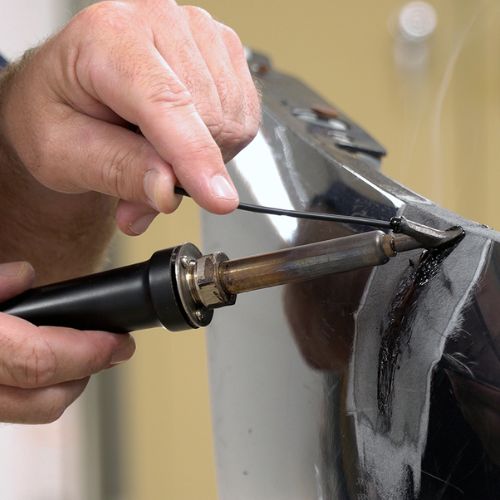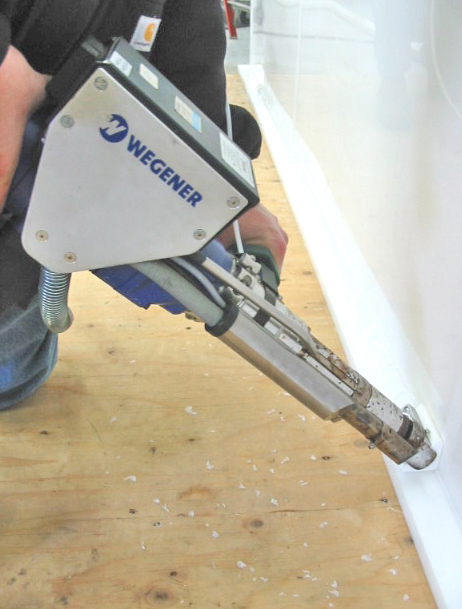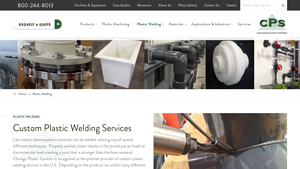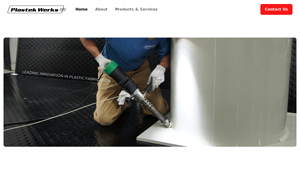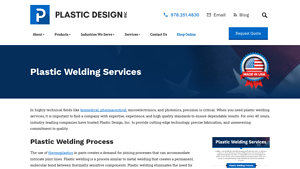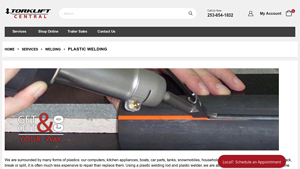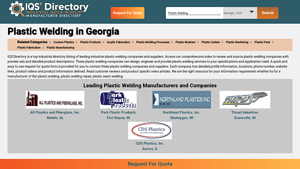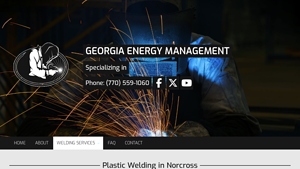Plastic Welding Services Guide: Type, Cost, Top List…
Introduction: Navigating the Global Market for plastic welding services
In the ever-evolving landscape of global manufacturing, sourcing reliable plastic welding services presents a unique challenge for B2B buyers. Companies across Africa, South America, the Middle East, and Europe face pressures to meet stringent quality standards while optimizing costs and ensuring timely delivery. This guide aims to demystify the complex world of plastic welding, providing insights into various techniques, applications, and the critical factors for selecting the right suppliers.
Plastic welding is not just a manufacturing process; it’s a pivotal element in producing durable and efficient components for industries ranging from automotive to pharmaceuticals. The guide covers essential aspects such as the types of plastic welding techniques—like hot air, extrusion, and ultrasonic welding—and their specific applications across diverse sectors. Additionally, it will offer actionable strategies for vetting suppliers, understanding cost structures, and ensuring compliance with international standards.
By equipping international B2B buyers with comprehensive knowledge and tools, this guide empowers informed purchasing decisions. Whether you are looking to enhance product quality, reduce lead times, or navigate regulatory complexities, understanding the nuances of plastic welding services will position your business for success in a competitive global market.
Understanding plastic welding services Types and Variations
| Type Name | Key Distinguishing Features | Primary B2B Applications | Brief Pros & Cons for Buyers |
|---|---|---|---|
| Hot Air Welding | Utilizes heated air to melt welding rod and base materials | Tanks, pipes, and industrial components | Pros: Cost-effective, versatile. Cons: Slower for large parts. |
| Extrusion Welding | Involves feeding a heated rod into the weld joint | Heavy-duty structures, large assemblies | Pros: Strong joints, suitable for thick materials. Cons: Equipment can be expensive. |
| Ultrasonic Welding | Uses high-frequency sound waves to generate heat at the joint | Electronics, automotive components | Pros: Quick, precise, minimal thermal distortion. Cons: Limited to thin materials. |
| Hot Plate Welding | Employs heated plates to bond materials together | Automotive parts, large plastic sheets | Pros: Excellent for large surfaces, strong joints. Cons: Longer setup time. |
| Laser Welding | Utilizes laser energy for precision welding | Medical devices, aerospace components | Pros: High precision, clean welds. Cons: Higher initial costs. |
What are the Key Characteristics of Hot Air Welding?
Hot air welding is a widely utilized method where clean, hot air is directed onto the materials being joined. The process requires a welding rod made of the same material as the parts to ensure compatibility. This technique is particularly suitable for applications involving tanks and piping systems. When considering hot air welding, buyers should evaluate the size and complexity of the components, as this method is more efficient for smaller, less complex parts.
How Does Extrusion Welding Stand Out?
Extrusion welding is characterized by its ability to handle thicker materials and larger assemblies. In this process, a heated rod is extruded into the joint, creating a robust weld. It is ideal for heavy-duty applications such as industrial tanks and structural components. Buyers should consider the initial investment in specialized equipment, but the strength and durability of the welds often justify the cost for projects requiring high structural integrity.
What Makes Ultrasonic Welding a Preferred Choice?
Ultrasonic welding employs high-frequency sound waves to generate localized heat at the joint interface, resulting in a strong bond. This method is particularly effective for thin materials and is commonly used in the electronics and automotive industries. Buyers should assess the material thickness and the desired production speed, as ultrasonic welding offers rapid cycle times, making it suitable for high-volume applications.
Why Choose Hot Plate Welding?
Hot plate welding uses heated plates to melt the surfaces of the materials being joined, allowing for a strong bond upon cooling. This method is advantageous for larger plastic sheets and automotive parts. The setup time can be longer compared to other methods, so buyers should weigh the benefits of strong welds against the potential for longer lead times in production.
What are the Benefits of Laser Welding?
Laser welding is known for its precision and ability to create clean, high-quality welds. It is particularly suited for sensitive applications in the medical and aerospace sectors, where precision is paramount. While the initial cost of laser welding equipment can be high, its efficiency and accuracy can lead to significant long-term savings in production costs. Buyers should consider the material types and thicknesses they plan to weld, as this method is often limited to specific applications.
Key Industrial Applications of plastic welding services
| Industry/Sector | Specific Application of Plastic Welding Services | Value/Benefit for the Business | Key Sourcing Considerations for this Application |
|---|---|---|---|
| Aerospace | Joining lightweight composite components for aircraft interiors. | Reduces overall weight, enhancing fuel efficiency and performance. | Compliance with stringent safety and quality standards; material compatibility. |
| Pharmaceutical | Fabrication of custom tanks and piping for chemical processes. | Ensures contamination-free environments, critical for product integrity. | Certifications such as FDA compliance; precision in manufacturing processes. |
| Water Treatment | Construction of water filtration systems and tanks. | Enhances durability and efficiency of water treatment operations. | Resistance to chemicals and UV exposure; custom sizes for specific installations. |
| Automotive | Production of plastic housings and components for vehicles. | Improves vehicle performance and reduces weight, leading to better fuel economy. | Material specifications for temperature and impact resistance; scalability for production runs. |
| Food Processing | Manufacturing of food-grade containers and processing equipment. | Ensures safety and compliance with health regulations. | Certification for food safety standards; ease of cleaning and maintenance. |
How Are Plastic Welding Services Utilized in Aerospace Applications?
In the aerospace industry, plastic welding services are critical for creating lightweight composite components used in aircraft interiors, such as panels and storage units. The reduced weight not only enhances fuel efficiency but also contributes to overall performance. Buyers in this sector must ensure that the welding services meet stringent safety and quality standards, as well as compatibility with specialized aerospace materials. This requires suppliers to demonstrate expertise in advanced welding techniques and materials.
What Role Does Plastic Welding Play in Pharmaceutical Manufacturing?
Plastic welding is extensively used in the pharmaceutical sector for fabricating custom tanks and piping systems essential for chemical processes. These welded structures are designed to maintain a contamination-free environment, which is crucial for product integrity and safety. Buyers should prioritize suppliers with certifications such as FDA compliance and those who can guarantee precision in their manufacturing processes. This ensures that the welded components can withstand the rigorous demands of pharmaceutical production.
Why is Plastic Welding Important for Water Treatment Systems?
In water treatment applications, plastic welding services are employed to construct durable filtration systems and tanks. The welded joints provide enhanced durability and operational efficiency, ensuring long-term performance in challenging environments. Buyers should consider the chemical resistance and UV stability of the materials used, as these factors significantly influence the lifespan of the systems. Custom sizes and configurations may also be necessary, highlighting the importance of working with adaptable suppliers.
How Do Automotive Applications Benefit from Plastic Welding Services?
The automotive industry relies on plastic welding for the production of various components, including housings and other critical parts. By using welded plastic parts, manufacturers can reduce vehicle weight, which directly contributes to improved fuel economy and performance. Buyers must focus on sourcing materials that meet specific temperature and impact resistance standards. Additionally, the ability to scale production runs is vital, as automotive manufacturers often require high volumes of consistent quality components.
What are the Advantages of Plastic Welding in Food Processing?
In food processing, plastic welding services are essential for creating food-grade containers and processing equipment that meet stringent health regulations. The welded joints ensure the integrity and safety of food products, preventing contamination. Buyers in this sector should look for suppliers who can provide certification for food safety standards and demonstrate ease of cleaning and maintenance in their products. This is crucial for maintaining compliance and ensuring operational efficiency in food processing environments.
3 Common User Pain Points for ‘plastic welding services’ & Their Solutions
Scenario 1: Delays in Production Due to Inconsistent Quality of Welds
The Problem: B2B buyers often encounter challenges when sourcing plastic welding services, especially regarding the quality of welds. Inconsistent welding results can lead to defective products, which cause delays in production timelines and increase costs associated with rework or scrap. These issues can be especially detrimental for industries that rely on just-in-time manufacturing processes, where timing and precision are critical. Buyers may find themselves frustrated when their suppliers fail to meet quality standards, leading to unexpected downtime and loss of customer trust.
The Solution: To mitigate the risk of inconsistent quality, buyers should prioritize sourcing from plastic welding service providers with robust quality assurance processes. Look for suppliers that are ISO certified or have similar quality certifications, as this indicates a commitment to maintaining high standards. It’s also essential to engage in thorough discussions about the specific welding techniques being employed, as different methods may yield varying results depending on the application. Implementing a pilot run before committing to larger production volumes can help assess the quality of welds firsthand. Additionally, establishing clear specifications and expectations upfront can guide the supplier in delivering consistent results that align with your project requirements.
Scenario 2: Limited Knowledge of Welding Techniques and Their Applications
The Problem: Many buyers lack in-depth knowledge about the various plastic welding techniques available and their specific applications. This knowledge gap can lead to selecting inappropriate welding methods, resulting in suboptimal product performance or even failure in critical applications. For instance, a buyer might opt for a basic hot air welding technique for a high-stress application where a more robust method, like ultrasonic welding, would be necessary. This oversight can compromise product integrity and safety, particularly in industries like automotive and aerospace.
The Solution: To address this knowledge gap, buyers should invest time in understanding the various plastic welding techniques and their appropriate applications. Engaging with suppliers who offer educational resources, such as workshops or detailed technical documentation, can be invaluable. Before initiating a project, buyers should conduct a thorough assessment of their product requirements, including material compatibility and performance criteria. Collaborating closely with experienced welding engineers or consultants can also provide insights into the most suitable welding methods. Furthermore, leveraging case studies from suppliers that demonstrate successful applications of different welding techniques can enhance decision-making and ensure the right approach is taken.
Scenario 3: Cost Management and Budget Overruns
The Problem: Budget constraints are a significant concern for many B2B buyers when outsourcing plastic welding services. Unexpected costs can arise from various factors, such as hidden fees, underestimation of production runs, or the need for additional rework due to poor initial weld quality. These financial surprises can jeopardize project viability, particularly for startups or small manufacturers that operate on thin margins. Buyers often find themselves scrambling to manage these costs, which can lead to strained supplier relationships and project delays.
The Solution: To effectively manage costs, buyers should establish a transparent budget and communicate it clearly to potential suppliers during the initial discussions. Request detailed quotes that break down all associated costs, including setup fees, material costs, and potential additional charges for modifications or rework. It’s also beneficial to inquire about bulk pricing or long-term contracts that may offer cost savings. Additionally, consider investing in a fixed-price contract for larger projects, which can help lock in costs and minimize the risk of budget overruns. Maintaining open lines of communication with suppliers throughout the project can also facilitate quick adjustments and keep the project on budget, ensuring that both parties remain aligned on expectations and deliverables.
Strategic Material Selection Guide for plastic welding services
What Are the Key Properties of Common Materials Used in Plastic Welding?
When selecting materials for plastic welding, it is crucial to understand their properties, advantages, and limitations. This knowledge helps businesses make informed decisions tailored to their specific applications and regional requirements.
Polypropylene (PP)
Polypropylene is a widely used thermoplastic known for its versatility and robustness. It boasts a high melting point (around 160°C) and excellent chemical resistance, making it suitable for applications in industries such as automotive and packaging. Its lightweight nature contributes to cost savings in transportation and handling.
Pros: Polypropylene is durable and resistant to many solvents, acids, and bases. It is also relatively inexpensive compared to other plastics, which can enhance profitability for manufacturers.
Cons: While it is resistant to many chemicals, it can be susceptible to environmental stress cracking. Additionally, its lower temperature resistance compared to other materials may limit its use in high-temperature applications.
Impact on Application: Polypropylene is ideal for applications involving food packaging and automotive components, where chemical resistance and lightweight properties are essential.
International Considerations: Buyers in regions like Africa and South America should ensure compliance with local regulations regarding food safety and environmental standards. Familiarity with ASTM and ISO standards is also beneficial.
Polyvinyl Chloride (PVC)
PVC is one of the most commonly used plastics in construction and plumbing due to its excellent durability and resistance to corrosion. It can withstand temperatures up to 60°C and is often used in applications requiring long-term exposure to moisture.
Pros: PVC is cost-effective and offers excellent resistance to environmental degradation. Its rigidity and strength make it suitable for structural applications.
Cons: The welding process for PVC can be more complex due to its tendency to release harmful gases when heated. Moreover, it may not be suitable for high-temperature applications.
Impact on Application: PVC is widely used in piping, window frames, and flooring, where its durability and resistance to moisture are critical.
International Considerations: In regions like the Middle East, where high temperatures are common, it is essential to assess the suitability of PVC for specific applications. Compliance with local building codes and standards such as DIN is crucial.
Acrylonitrile Butadiene Styrene (ABS)
ABS is a strong, impact-resistant thermoplastic known for its excellent toughness and rigidity. It can withstand temperatures up to 80°C and is often used in consumer products and automotive parts.
Pros: ABS is easy to machine and fabricate, making it a popular choice for prototyping and low-volume production. Its aesthetic qualities also make it suitable for consumer-facing products.
Cons: While ABS is durable, it can be prone to UV degradation if not treated properly. Its higher cost compared to other plastics may also be a consideration for budget-sensitive projects.
Impact on Application: ABS is commonly used in applications requiring high impact resistance, such as in automotive interiors and electronic housings.
International Considerations: Buyers should consider the availability of ABS in their region and ensure compliance with safety standards relevant to consumer products, especially in Europe where regulations are stringent.
Summary Table of Common Materials for Plastic Welding
| Material | Typical Use Case for plastic welding services | Key Advantage | Key Disadvantage/Limitation | Relative Cost (Low/Med/High) |
|---|---|---|---|---|
| Polypropylene (PP) | Food packaging, automotive components | High chemical resistance | Susceptible to environmental stress cracking | Low |
| Polyvinyl Chloride (PVC) | Plumbing, construction | Cost-effective and durable | Releases harmful gases when heated | Low |
| Acrylonitrile Butadiene Styrene (ABS) | Consumer products, automotive parts | Excellent toughness and aesthetic quality | Prone to UV degradation | Medium |
This comprehensive overview of material properties and considerations provides B2B buyers with actionable insights to make informed decisions regarding plastic welding services. Understanding the nuances of each material can lead to improved product performance and compliance with international standards.
In-depth Look: Manufacturing Processes and Quality Assurance for plastic welding services
What Are the Key Stages of the Manufacturing Process for Plastic Welding Services?
The manufacturing process for plastic welding services typically encompasses several critical stages: material preparation, forming, assembly, and finishing. Each stage is essential to ensure the final product meets the required specifications and quality standards.
Material Preparation
The first step in the manufacturing process involves selecting and preparing the appropriate thermoplastic materials. This selection is crucial, as the welding technique employed depends heavily on the type of plastic being used. Common materials include polyethylene, polypropylene, PVC, and various engineering plastics. The materials are often cut to size and cleaned to remove any contaminants that could affect the welding process. This preparation phase may also involve drying the plastics to eliminate moisture, which can lead to defects in the welded joint.
What Forming Techniques Are Commonly Used in Plastic Welding?
Forming techniques in plastic welding vary widely, depending on the application and the specific properties required in the final product. Key methods include:
-
Hot Gas Welding: This involves using a heat gun to melt the edges of the plastic parts while simultaneously applying a welding rod made from the same material. This technique is ideal for thinner materials and allows for strong joints through molecular fusion.
-
Extrusion Welding: This method is suitable for larger and thicker materials. An extruder heats the welding rod and feeds it into the weld seam under pressure, creating a robust joint. This technique is particularly effective for heavy-duty applications.
-
Hot Plate Welding: In this process, the plastic parts are placed against a heated plate to soften their surfaces before being pressed together. This method is often used in the automotive and aerospace industries due to its reliability.
-
Infrared Welding: Infrared radiation is used to heat the surfaces of the materials, allowing for precise control over the welding process. This technique is beneficial for complex geometries and sensitive applications.
How Is Assembly Conducted in the Plastic Welding Process?
The assembly phase involves joining the prepared plastic components using the chosen welding technique. This stage is critical as it directly affects the structural integrity and functionality of the final product. Skilled technicians monitor the welding parameters, including temperature, pressure, and speed, to ensure that the welds are consistent and meet the required specifications.
After assembly, the welded parts may undergo additional processes, such as machining or trimming, to achieve the desired dimensions and tolerances.
What Finishing Processes Are Applied to Enhance Plastic Welded Products?
Finishing processes are vital for improving the aesthetic and functional qualities of welded plastic components. Common finishing techniques include:
-
Surface Finishing: This may involve sanding, polishing, or applying coatings to enhance the visual appeal and protect against environmental factors.
-
Quality Inspections: A thorough inspection of the welded joints is conducted to identify any defects or inconsistencies. This can include visual inspections and non-destructive testing methods such as ultrasonic testing or dye penetrant testing.
-
Assembly of Additional Components: If the final product includes additional parts, they may be assembled during this stage, ensuring that all components function seamlessly together.
How Is Quality Assurance Implemented in Plastic Welding Services?
Quality assurance is critical in the manufacturing of plastic welded products, particularly in international markets where standards may vary. Most reputable plastic welding service providers adhere to international quality standards, such as ISO 9001, which outlines requirements for a quality management system.
What International Standards Are Relevant to Plastic Welding?
International standards like ISO 9001 provide a framework for ensuring consistent quality in manufacturing processes. Additionally, industry-specific certifications such as CE marking (for products sold in the European Economic Area) and API (American Petroleum Institute) standards for products used in the petroleum industry may apply.
What Are the Key Quality Control Checkpoints in Plastic Welding?
Quality control (QC) is integrated throughout the manufacturing process and typically includes several checkpoints:
-
Incoming Quality Control (IQC): Materials are inspected upon arrival to ensure they meet specified requirements before being used in production.
-
In-Process Quality Control (IPQC): During the welding process, parameters such as temperature and pressure are monitored continuously to ensure they remain within acceptable limits.
-
Final Quality Control (FQC): After the welding is complete, the finished products undergo rigorous testing to verify that they meet all specifications and standards.
What Common Testing Methods Are Used to Ensure Quality?
Testing methods employed in quality assurance may include:
-
Visual Inspections: Technicians examine welds for surface defects, inconsistencies, or signs of weakness.
-
Mechanical Testing: Products may undergo tensile, impact, or shear testing to assess their strength and durability.
-
Non-Destructive Testing (NDT): Techniques like ultrasonic testing and radiographic testing can detect internal defects without damaging the product.
How Can B2B Buyers Verify Supplier Quality Control?
B2B buyers should take several steps to verify the quality control practices of plastic welding service providers:
-
Conduct Audits: Regular audits of suppliers can provide insights into their manufacturing processes and adherence to quality standards.
-
Request Quality Reports: Suppliers should be able to provide documentation of their quality control measures, including inspection reports and testing results.
-
Third-Party Inspections: Engaging independent third-party inspectors can offer an objective assessment of the supplier’s quality control practices.
What Are the Nuances of Quality Control for International Buyers?
International B2B buyers, particularly from regions such as Africa, South America, the Middle East, and Europe, should be aware of specific nuances in quality control:
-
Regulatory Compliance: Different countries may have varying regulatory requirements, making it essential to ensure that the supplier complies with local standards.
-
Cultural Differences: Understanding cultural attitudes towards quality and compliance can aid in building better relationships with suppliers.
-
Logistical Considerations: Shipping products across borders may introduce additional quality risks, so buyers should ensure that suppliers have robust processes for handling international orders.
By understanding these processes and quality assurance measures, B2B buyers can make informed decisions when selecting plastic welding service providers, ensuring that they receive high-quality products that meet their specific needs.
Practical Sourcing Guide: A Step-by-Step Checklist for ‘plastic welding services’
Introduction
When sourcing plastic welding services, B2B buyers must navigate a complex landscape of suppliers and technologies. This guide provides a step-by-step checklist designed to streamline your procurement process, ensuring you find a provider that meets your specific requirements while maintaining quality and compliance. By following these steps, you can make informed decisions that align with your project goals and industry standards.
Step 1: Define Your Technical Specifications
Before reaching out to suppliers, clearly outline your technical requirements. This includes the types of plastics involved, the welding techniques needed (e.g., hot air, extrusion, or infrared welding), and the dimensions of the components. Precise specifications help suppliers understand your needs and ensure they can deliver the appropriate solutions.
- Material Types: Identify whether you need welding for thermoplastics like PVC, polypropylene, or specialized materials.
- Joint Strength Requirements: Specify the desired strength and durability of the welds to meet your application needs.
Step 2: Research Potential Suppliers
Conduct thorough research to identify potential plastic welding service providers. Utilize online directories, industry forums, and trade associations to compile a list of suppliers that specialize in your required services.
- Geographical Considerations: Consider suppliers from regions with strong reputations in plastic welding, such as the U.S. and Europe, to ensure quality and compliance with international standards.
- Industry Experience: Look for suppliers with a proven track record in your industry, as they will better understand your unique challenges.
Step 3: Evaluate Supplier Capabilities
Assess the capabilities of each potential supplier to ensure they can meet your requirements. This includes reviewing their equipment, technology, and workforce expertise.
- Technology and Equipment: Ensure they have modern welding technologies and machinery suitable for your project specifications.
- Production Capacity: Confirm that the supplier can handle your volume needs, whether for prototyping or large-scale production.
Step 4: Verify Supplier Certifications
Check for relevant certifications that validate the supplier’s quality management and compliance with industry standards. Certifications such as ISO 9001 or specific industry-related credentials can indicate a commitment to quality.
- Quality Assurance Practices: Inquire about their quality control processes and how they ensure consistent results.
- Compliance with Regulations: Ensure they adhere to local and international safety and environmental regulations.
Step 5: Request Quotes and Proposals
Once you have narrowed down your list of potential suppliers, request detailed quotes and proposals. This will give you insight into pricing structures, lead times, and the services included.
- Comparative Analysis: Compare quotes not only based on price but also on the value offered, including additional services like prototyping or after-sales support.
- Lead Times: Assess the timelines provided to ensure they align with your project schedule.
Step 6: Conduct Site Visits or Virtual Tours
If feasible, arrange site visits to observe the supplier’s operations. Alternatively, request virtual tours to gauge their facilities and processes.
- Operational Standards: This helps verify the supplier’s capabilities and adherence to safety and quality standards firsthand.
- Cultural Fit: Understanding their operational culture can help determine if they are a suitable partner for long-term collaboration.
Step 7: Check References and Case Studies
Finally, seek references and review case studies from past clients. This provides insights into the supplier’s reliability, quality of work, and customer service.
- Client Feedback: Speak with previous clients to gauge their experiences and satisfaction levels.
- Relevance to Your Industry: Focus on case studies that showcase projects similar to yours to better understand the supplier’s expertise in your specific area.
By following this checklist, you can systematically evaluate and select the right plastic welding service provider to meet your business needs.
Comprehensive Cost and Pricing Analysis for plastic welding services Sourcing
What Are the Key Cost Components of Plastic Welding Services?
Understanding the cost structure of plastic welding services is crucial for B2B buyers. The primary cost components include:
-
Materials: The type of plastic used significantly impacts costs. Common materials include polypropylene, PVC, and polyethylene, each varying in price and availability. Additionally, if specialized welding rods or adhesives are required, this will further influence material costs.
-
Labor: Skilled labor is essential for effective plastic welding. Labor costs can vary based on geographic location and the expertise required for specific welding techniques (e.g., hot gas, extrusion welding). Skilled technicians typically command higher wages, affecting overall pricing.
-
Manufacturing Overhead: This includes costs related to facility maintenance, utilities, and equipment depreciation. Advanced welding machinery and technologies, such as robotic welding systems, can elevate overhead expenses.
-
Tooling: Custom tooling for specific projects can incur significant upfront costs. This is particularly relevant for unique designs or high-volume production runs, where tooling costs are amortized over larger quantities.
-
Quality Control (QC): Ensuring that welded products meet industry standards requires investment in QC processes. This can involve testing for durability, strength, and compliance with certifications, which adds to the overall cost.
-
Logistics: Shipping costs can vary significantly depending on the destination, especially for international buyers. Factors like freight charges, insurance, and customs duties must be considered in the total cost.
-
Margin: Suppliers typically include a profit margin in their pricing. This margin can vary based on competition, market demand, and supplier reputation.
How Do Price Influencers Affect Plastic Welding Costs?
Several factors can influence the pricing of plastic welding services:
-
Volume and Minimum Order Quantity (MOQ): Larger orders often lead to reduced unit costs. Negotiating favorable terms for high-volume projects can yield significant savings.
-
Specifications and Customization: Custom designs or specific tolerances may increase costs. Clear communication of requirements can help avoid unexpected expenses.
-
Material Selection: The choice of materials can greatly affect pricing. Some plastics are more expensive than others, and sourcing from different suppliers can yield cost differences.
-
Quality and Certifications: Products requiring specific quality certifications or compliance with international standards (e.g., ISO, RoHS) may incur additional costs due to the rigorous testing and documentation processes.
-
Supplier Factors: Established suppliers with a proven track record may charge more due to their reliability and quality assurance. However, they often provide better service and support, which can justify the higher price.
-
Incoterms: Understanding Incoterms is crucial for international transactions. Terms like FOB (Free On Board) or CIF (Cost, Insurance, and Freight) can significantly affect total landed costs.
What Buyer Tips Can Help Optimize Costs in Plastic Welding Services?
B2B buyers can implement several strategies to optimize their sourcing costs:
-
Effective Negotiation: Leverage volume purchases to negotiate better pricing. Establish long-term relationships with suppliers to gain favorable terms and conditions.
-
Cost-Efficiency Analysis: Consider the Total Cost of Ownership (TCO) rather than just upfront costs. This includes evaluating the lifespan and performance of welded products, which can affect long-term operational costs.
-
Pricing Nuances for International Buyers: Be aware of currency fluctuations, tariffs, and import duties that can impact pricing. Establishing contracts in stable currencies can mitigate some of these risks.
-
Supplier Comparison: Conduct thorough research to compare multiple suppliers. Look beyond price; consider factors such as lead times, quality assurance processes, and past performance.
-
Clear Specifications: Providing detailed specifications can prevent costly revisions and ensure that the final product meets expectations, thus avoiding additional costs associated with rework.
In summary, understanding the cost components and price influencers in plastic welding services is essential for making informed purchasing decisions. By leveraging negotiation strategies and considering the total cost of ownership, international B2B buyers can optimize their sourcing efforts and secure favorable agreements.
Alternatives Analysis: Comparing plastic welding services With Other Solutions
Understanding Alternatives to Plastic Welding Services
In the realm of industrial applications, plastic welding services stand out as a specialized solution for joining thermoplastic materials. However, various alternative methods can also achieve similar objectives. Evaluating these alternatives is crucial for B2B buyers looking to optimize their manufacturing processes, control costs, and ensure product quality. Below, we compare plastic welding services against two viable alternatives: adhesive bonding and mechanical fastening.
Comparison Table
| Comparison Aspect | Plastic Welding Services | Adhesive Bonding | Mechanical Fastening |
|---|---|---|---|
| Performance | High-strength, permanent joints | Variable strength, can be permanent or temporary | Strong but may allow for disassembly |
| Cost | Moderate to high depending on method | Generally lower initial cost | Low to moderate; costs vary with materials used |
| Ease of Implementation | Requires skilled labor and specialized equipment | Easy to apply, minimal training needed | Simple, requires basic tools |
| Maintenance | Low maintenance once completed | May require inspection over time | Moderate, depending on the environment |
| Best Use Case | High-stress applications needing durability | Lightweight applications, low-stress environments | Assembly requiring disassembly or adjustment |
Detailed Breakdown of Alternatives
What Are the Benefits and Drawbacks of Adhesive Bonding?
Adhesive bonding is a process where two surfaces are joined using a chemical adhesive. This method is advantageous due to its ease of application and lower initial costs compared to plastic welding. Adhesives can bond a variety of materials, making them suitable for diverse applications. However, the performance of adhesive bonds can vary significantly based on the adhesive type and environmental factors, such as temperature and moisture. In high-stress applications, adhesives may not provide the same level of durability as welded joints, potentially leading to failures over time.
How Does Mechanical Fastening Compare to Plastic Welding?
Mechanical fastening involves joining parts using hardware like screws, bolts, or rivets. This method is straightforward and requires minimal training, making it easy to implement. Mechanical fastening allows for disassembly, which can be beneficial in applications where maintenance or adjustments are necessary. However, it may not provide the same level of strength and permanence as plastic welding, especially in high-stress environments. Additionally, mechanical joints can introduce points of failure if not properly designed, leading to potential reliability issues.
Conclusion: How Should B2B Buyers Choose the Right Solution?
When selecting the best joining method for plastic components, B2B buyers should carefully consider their specific requirements, including the intended application, environmental conditions, and budget constraints. Plastic welding services are ideal for high-performance applications where durability and strength are paramount. Conversely, adhesive bonding may suit projects with lower stress demands and tighter budgets, while mechanical fastening is appropriate for applications requiring flexibility and easy assembly. By evaluating these factors, buyers can make informed decisions that align with their operational goals and quality standards.
Essential Technical Properties and Trade Terminology for plastic welding services
What Are the Key Technical Properties in Plastic Welding Services?
Understanding the technical properties of plastic welding is crucial for B2B buyers looking to ensure quality and compatibility in their projects. Here are some essential specifications:
-
Material Grade
Material grade refers to the classification of the plastic used, indicating its quality and performance characteristics. Common materials include polypropylene (PP), polyethylene (PE), and polyvinyl chloride (PVC). Each material has unique thermal and mechanical properties, affecting the welding process and the final product’s strength and durability. Selecting the appropriate material grade ensures the finished product meets industry standards and application requirements. -
Welding Temperature
The welding temperature is the precise heat required to fuse plastic materials effectively. Different plastics have varying melting points, which must be meticulously controlled during the welding process. Ensuring the correct welding temperature is vital for achieving a strong molecular bond between the materials, preventing issues such as warping or incomplete fusions that can compromise the integrity of the final product. -
Tolerances
Tolerance refers to the allowable variation in dimensions of the welded components. In industries like aerospace and automotive, where precision is critical, maintaining tight tolerances can significantly impact the performance and safety of the application. B2B buyers should prioritize suppliers that can consistently meet specified tolerances to ensure seamless integration into their assemblies. -
Joint Design
The design of the weld joint plays a crucial role in the strength and quality of the finished product. Factors such as joint geometry, surface preparation, and alignment must be carefully considered. An optimized joint design not only enhances the strength of the weld but also influences the overall aesthetic and functionality of the final assembly. -
Production Volume
Understanding the production volume is essential for determining the most suitable welding technique and equipment. Whether the need is for prototype runs or high-volume production, the choice of welding method can affect cost, lead time, and scalability. Buyers should communicate their volume requirements clearly to ensure that suppliers can meet their needs efficiently.
What Are Common Trade Terms in Plastic Welding Services?
Familiarity with industry terminology can streamline communication and negotiations between B2B buyers and suppliers. Here are some common terms:
-
OEM (Original Equipment Manufacturer)
OEM refers to companies that produce parts or equipment that may be marketed by another manufacturer. For B2B buyers, working with OEMs can ensure that the components are designed to fit perfectly within existing systems, maintaining compatibility and performance. -
MOQ (Minimum Order Quantity)
MOQ is the smallest quantity of a product that a supplier is willing to sell. Understanding MOQs is vital for B2B buyers to manage inventory costs and production schedules effectively. Suppliers often set MOQs to ensure profitability, making it crucial for buyers to align their purchasing strategies accordingly. -
RFQ (Request for Quotation)
An RFQ is a document sent by a buyer to potential suppliers requesting pricing and terms for specific products or services. This term is essential for initiating the procurement process and helps buyers compare offers from different suppliers to make informed decisions. -
Incoterms (International Commercial Terms)
Incoterms are a set of predefined commercial terms published by the International Chamber of Commerce (ICC) that define the responsibilities of buyers and sellers in international transactions. Familiarity with Incoterms helps B2B buyers understand shipping costs, risk management, and the logistics of getting products from suppliers to their operations. -
Lead Time
Lead time refers to the amount of time it takes from placing an order to receiving the goods. For B2B buyers, understanding lead times is critical for planning production schedules and managing supply chain logistics. Suppliers should provide clear lead time estimates to help buyers avoid delays in their operations.
By grasping these technical properties and trade terms, B2B buyers can make more informed decisions when selecting plastic welding services, ultimately leading to successful project outcomes.
Navigating Market Dynamics and Sourcing Trends in the plastic welding services Sector
What Are the Current Market Dynamics and Key Trends in Plastic Welding Services?
The global plastic welding services market is experiencing significant growth, driven by rising demand across various industries, including automotive, aerospace, and medical. The increasing adoption of thermoplastics due to their lightweight and durable properties is a primary driver. Additionally, advancements in welding technologies, such as ultrasonic and laser welding, are enabling manufacturers to produce more intricate designs with enhanced precision. This trend is particularly relevant for international B2B buyers from regions like Africa, South America, the Middle East, and Europe, where emerging economies are ramping up their manufacturing capabilities.
Moreover, the rise of automation and Industry 4.0 technologies is reshaping sourcing strategies. Businesses are increasingly leveraging data analytics and IoT devices to optimize production processes and supply chain management. This shift allows for improved quality control, reduced downtime, and enhanced operational efficiency, making it critical for buyers to consider suppliers that invest in these technologies.
Lastly, as global trade dynamics evolve, international buyers should be aware of tariffs, trade agreements, and geopolitical factors that could impact sourcing. Understanding local regulations and compliance requirements in target markets is essential for mitigating risks and ensuring smooth operations.
How Are Sustainability and Ethical Sourcing Impacting the Plastic Welding Services Sector?
Sustainability has become a pivotal consideration in the plastic welding services sector. The environmental impact of plastic production and waste is under increasing scrutiny, prompting businesses to adopt more sustainable practices. This includes the use of recycled materials and eco-friendly welding techniques that minimize energy consumption and emissions.
For B2B buyers, emphasizing ethical sourcing and sustainability can enhance brand reputation and customer loyalty. Companies are now actively seeking suppliers with green certifications, such as ISO 14001, which indicates a commitment to environmental management. Additionally, utilizing bioplastics and other renewable materials is gaining traction, offering a competitive edge in a market that increasingly values eco-conscious practices.
Furthermore, transparency in supply chains is becoming essential. Buyers are encouraged to partner with suppliers who demonstrate ethical labor practices and environmental stewardship. This focus not only aligns with consumer preferences but also prepares businesses for future regulations aimed at reducing carbon footprints and promoting sustainable production methods.
How Has the Plastic Welding Services Market Evolved Over Time?
The evolution of plastic welding services can be traced back several decades, with its roots in the growing use of plastics in various applications. Initially, traditional welding methods were adapted for thermoplastics, but as industries recognized the advantages of plastics—such as weight reduction and corrosion resistance—more specialized techniques emerged.
In the 1980s and 1990s, advancements in technology led to the development of more sophisticated welding methods, including ultrasonic and laser welding, which offered greater precision and efficiency. Over the years, the market has expanded to accommodate a wider range of materials and applications, from automotive components to medical devices.
Today, the plastic welding sector stands at the intersection of innovation and sustainability, continually adapting to meet the challenges posed by modern manufacturing demands. As the industry progresses, international B2B buyers can expect to see continued advancements in both technology and sustainable practices, shaping the future of plastic welding services.
Frequently Asked Questions (FAQs) for B2B Buyers of plastic welding services
-
How do I choose the right plastic welding service for my project?
When selecting a plastic welding service, consider the specific materials and welding techniques required for your project. Look for suppliers with experience in your industry and a proven track record. Request case studies or references to gauge their expertise. Additionally, evaluate their facility capabilities, certifications, and compliance with international standards. Engaging in direct communication can help clarify their customization options and lead times, ensuring they align with your project timelines. -
What are the most common plastic welding techniques used in B2B applications?
The most common plastic welding techniques include hot gas welding, extrusion welding, and hot plate welding. Hot gas welding is ideal for thinner materials, while extrusion welding is suitable for thicker sections, providing a robust bond. Hot plate welding offers a consistent joint for large surface areas. Understanding the advantages of each technique will help you select the right method for your specific application, ensuring optimal performance and durability of the welded product. -
What factors should I consider regarding minimum order quantities (MOQs) for plastic welding services?
MOQs for plastic welding services can vary significantly based on the supplier, the complexity of the project, and the materials used. It’s important to discuss your requirements upfront, as some suppliers may accommodate low-volume orders for prototypes or custom projects. However, higher volumes often lead to reduced per-unit costs. Understanding the supplier’s production capabilities and flexibility will help you negotiate favorable terms that align with your business needs. -
How can I ensure quality assurance (QA) in plastic welding services?
To ensure quality assurance in plastic welding, inquire about the supplier’s QA processes and certifications. Look for adherence to international standards such as ISO 9001. Request documentation of their testing methods, including inspections of weld strength and integrity. It’s beneficial to establish clear quality expectations in your contract, including acceptable tolerances and testing protocols. Regular communication throughout the production process can also help maintain quality. -
What payment terms are typically offered by plastic welding service providers?
Payment terms can vary among plastic welding service providers, but common arrangements include net 30 or net 60 days. Some suppliers may require a deposit upfront, especially for custom or high-volume orders. It’s crucial to clarify payment expectations and methods (e.g., wire transfer, credit terms) during negotiations. Discussing any potential discounts for early payment can also be beneficial for managing cash flow, especially for international transactions. -
How do logistics and shipping impact sourcing plastic welding services internationally?
Logistics and shipping play a critical role in international sourcing of plastic welding services. Consider the supplier’s location and the associated shipping costs, which can affect your overall budget. Additionally, understand the import regulations and tariffs in your country. Collaborate with your supplier to establish a clear timeline for production and delivery, ensuring that you account for potential delays. Efficient logistics management can enhance the reliability of your supply chain. -
What customization options are typically available for plastic welding projects?
Customization options in plastic welding can include variations in materials, sizes, and welding techniques tailored to specific applications. Many suppliers can accommodate unique design specifications or integrate components into existing systems. During the initial discussions, provide detailed project requirements and ask for their capability to handle custom designs. This collaboration will ensure that the final product meets your expectations and operational needs. -
How can I vet potential suppliers of plastic welding services?
Vetting potential suppliers requires a multi-faceted approach. Start by checking their industry experience and customer reviews. Request references from previous clients to evaluate their reliability and quality of work. Assess their certifications and compliance with relevant international standards. Additionally, consider visiting their facilities, if feasible, to observe their operations firsthand. Establishing a good rapport and transparent communication can also help build a trustworthy business relationship.
Important Disclaimer & Terms of Use
⚠️ Important Disclaimer
The information provided in this guide, including content regarding manufacturers, technical specifications, and market analysis, is for informational and educational purposes only. It does not constitute professional procurement advice, financial advice, or legal advice.
While we have made every effort to ensure the accuracy and timeliness of the information, we are not responsible for any errors, omissions, or outdated information. Market conditions, company details, and technical standards are subject to change.
B2B buyers must conduct their own independent and thorough due diligence before making any purchasing decisions. This includes contacting suppliers directly, verifying certifications, requesting samples, and seeking professional consultation. The risk of relying on any information in this guide is borne solely by the reader.
Top 6 Plastic Welding Services Manufacturers & Suppliers List
1. CPSFAB – Custom Plastic Welding Solutions
Domain: cpsfab.com
Registered: 2006 (19 years)
Introduction: Custom Plastic Welding Services, techniques include hot gas welding, extrusion welding, CNC butt welding, hot plate welding, infrared pipe welding. Materials used: PVC, PP (Polypropylene), PVDF, UHMW, HDPE, PANELTIM, PEEK, PTFE. Applications in industries such as Chemical Process, Metal Finishing, Food Manufacturing/Processing, Pharmaceutical, Water and Waste Water. Services offered for large and …
2. Plastek Werks – Custom Plastic Fabrication
Domain: plastekwerks.com
Registered: 1997 (28 years)
Introduction: {“Custom Plastic Fabrication”: “Design and manufacture complex plastic components tailored to specific industry needs.”, “Custom Tanks”: “Design and fabricate custom plastic tanks for chemical storage, wastewater systems, and industrial processes.”, “Concrete Protective Liners”: “Offer robust chemical protection for concrete structures in harsh environments.”, “Field Service & On-site Welding”: “C…
3. Plastic Design Inc. – Precision Plastic Welding Services
Domain: plasticdesigninc.com
Registered: 1998 (27 years)
Introduction: Plastic Welding Services offered by Plastic Design Inc. include:
– Expertise in precision welding for biomedical, pharmaceutical, microelectronics, and photonics industries.
– Over 40 years of experience with a commitment to quality and cutting-edge technology.
– Commonly used method: Hot gas welding, which creates a permanent molecular bond between thermoplastic materials without adhesives or mec…
4. Torklift Central – Plastic Welding Services
Domain: torkliftcentral.com
Registered: 2011 (14 years)
Introduction: Torklift Central offers plastic welding services to repair various plastic items such as computers, kitchen appliances, boats, car parts, tanks, snowmobiles, and household items. The service utilizes a plastic welding rod and plastic welder to fuse two pieces of the same type of plastic, making them like new again. The company emphasizes that repairing plastics is often more cost-effective than re…
5. IQS Directory – Plastic Welding Services
Domain: iqsdirectory.com
Registered: 2004 (21 years)
Introduction: Plastic welding services in Georgia, including design, engineering, and custom specifications. Companies offer flat plastic welding, plastic welding repair, and plastic seam welding. Related services include plastic fabrication, plastic machining, plastic molding processes, and plastic manufacturing. Companies provide detailed profiles with contact information, product videos, and customer reviews…
6. Georgia Energy Management – Plastic Welding Services
Domain: linknow.studio
Registered: 2018 (7 years)
Introduction: Plastic welding services in Norcross, Georgia, offered by Georgia Energy Management. Specializes in repairing damaged plastic using various techniques including hot gas rod welding, ultrasonic welding, extrusion welding, solvent cement welding, and adhesive bonding. Custom plastic fabrication services available for items such as windshields for recreational vehicles, display cases, bumpers, storag…
Strategic Sourcing Conclusion and Outlook for plastic welding services
In the ever-evolving landscape of plastic welding services, strategic sourcing has emerged as a critical factor for international B2B buyers looking to optimize operations and reduce costs. By collaborating with specialized suppliers who offer a range of welding techniques—such as hot air, extrusion, and infrared welding—businesses can achieve superior joint strength and durability in their products. This is particularly essential for industries like automotive, aerospace, and pharmaceuticals, where precision and reliability are non-negotiable.
Furthermore, understanding the capabilities of different manufacturers can empower buyers to tailor their sourcing strategies to meet specific project requirements, whether it’s for high-volume production runs or bespoke prototypes. As global demand for sustainable and efficient plastic solutions grows, engaging with experienced suppliers can also facilitate innovation and compliance with stringent regulatory standards.
Looking ahead, international buyers from regions like Africa, South America, the Middle East, and Europe are encouraged to leverage these insights to forge strategic partnerships that enhance their competitive edge. By prioritizing quality, technological advancement, and supplier reliability, businesses can position themselves for success in the dynamic market of plastic welding services. Reach out today to explore how strategic sourcing can transform your operations and drive growth.
